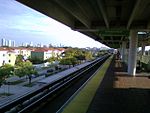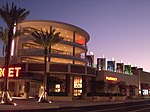Midtown Interchange
1968 establishments in FloridaFlorida road stubsInterstate 95Miami stubsRoad interchanges in Florida ... and 2 more
Roads in MiamiUse mdy dates from June 2018

The Midtown Interchange, located in the Civic Center and Overtown neighborhoods of Miami, Florida, is the convergence of three major motorways: I-95, I-395 (which connects to the MacArthur Causeway to the east), and the Dolphin Expressway (SR 836).
Excerpt from the Wikipedia article Midtown Interchange (License: CC BY-SA 3.0, Authors, Images).Midtown Interchange
Airport Expressway, Miami Wynwood
Geographical coordinates (GPS) Address Nearby Places Show on map
Geographical coordinates (GPS)
| Latitude | Longitude |
|---|---|
| N 25.812222 ° | E -80.206111 ° |
Address
Airport Expressway
33127 Miami, Wynwood
Florida, United States
Open on Google Maps




